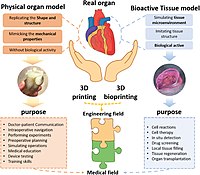
Photo from wikipedia
Despite significant progress in the development of renal tissue, recapitulation of perfusable complex renal tubular tissue with clinically relevant cellular heterogeneity is still remaining a challenge. In this study, using… Click to show full abstract
Despite significant progress in the development of renal tissue, recapitulation of perfusable complex renal tubular tissue with clinically relevant cellular heterogeneity is still remaining a challenge. In this study, using coaxial 3D cell-printing technique, we present microfluidic hollow tubes to realize tubular/vascular renal parenchyma composed of renal tubular epithelial and endothelial cells, respectively. We developed a functional hybrid bioink that inherits microenvironments for vascularized native kidney tissue with rapidly crosslinkable character to optimize cell functionality and retain the predefined hollow tubular structure. In addition, the novel bioink and 3D coaxial cell-printing technique provided a complex tube with tunable feature of monolayer and bilayer structure across the length of printed tube. Through prototyping a vascularized renal proximal tubule-on-a-chip, we showed its applicability to novel microfluidic renal tissue models. The renal subcapsular transplantation of the hollow tubes showed a long-term graft survival with the therapeutic capability of the tubular constructs in in vivo model of renal disease, which serves their applicability in regenerative medicine.
Journal Title: Biomaterials
Year Published: 2019
Link to full text (if available)
Share on Social Media: Sign Up to like & get
recommendations!